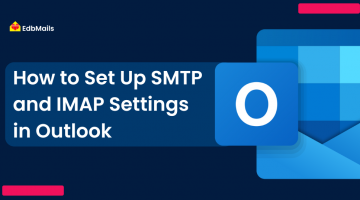Microsoft Exchange Server has long been the backbone of business communication, powering email, calendars, contacts, and collaboration for millions of organizations worldwide. From its early release with Exchange Server 4.0 to the latest Exchange Server 2019, it continues to provide enterprises with a secure and reliable messaging platform. However, like any IT system, Exchange databases are not immune to corruption, crashes, or human errors. When the Exchange database (EDB file) becomes corrupt or inaccessible, organizations risk losing critical communication data.
This is where Exchange recovery plays a vital role. In this article, we’ll explore why Exchange database recovery is important, the causes of EDB file corruption, and how to use EdbMails Exchange Recovery software to restore mailboxes and export them to PST, Office 365, or live Exchange servers.
What is an Exchange Database File (EDB)?
The EDB file (Exchange Database file) is the core repository of all data in Microsoft Exchange Server. It is based on the Extensible Storage Engine (ESE) and stores user mailboxes, emails, contacts, calendars, notes, and public folders.
- Before Exchange 2007: Two files were used – .edb for MAPI messages and .stm for streaming internet content.
- Exchange 2007 and later: The .stm file was deprecated, and all mailbox data is now stored in a single .edb file.
Because the EDB file contains the organization’s entire communication records, any corruption or inaccessibility can bring email communication to a halt. This makes EDB recovery a critical task for IT administrators.
Causes of Exchange Database (EDB) Corruption
Despite Microsoft’s built-in protections, Exchange databases are prone to corruption and data loss. Common causes include:
- Hardware Failures – Bad sectors on the hard drive or storage failures.
- Improper Shutdowns – Dirty shutdowns due to power outages or forced restarts.
- Malware or Ransomware Attacks – Malicious programs corrupting database files.
- Human Errors – Accidental deletion of mailboxes or configuration mishaps.
- Log File Issues – Missing or damaged Exchange transaction log files.
- Software Bugs or Updates – Incomplete patches or incompatibility.
- Server Crashes – Failure of the underlying Windows Server.
Because EDB files cannot be opened directly, admins face challenges in troubleshooting. Microsoft provides the Eseutil command-line tool, but it is complex, slow, and often ineffective in cases of severe corruption.
Why You Need Professional Exchange Recovery Software
While Microsoft’s tools can handle minor corruption, they are not reliable for severe database damage or large EDB files. This is where EdbMails Exchange Recovery comes in.
EdbMails offers:
- EDB to PST conversion for backup and easy import into Outlook.
- Direct migration from EDB to Office 365 (Microsoft 365).
- Direct migration from EDB to live Exchange Server (all versions).
- Recovery of deleted emails, contacts, calendars, and public folders.
- Support for Exchange versions 2000, 2003, 2007, 2010, 2013, 2016, and 2019.
- Free trial version that allows exporting 30 items per folder.
Step-by-Step Guide to Exchange Recovery with EdbMails
Step 1: Download and Install EdbMails
Step 2: Select EDB Recovery (Offline) and Migration.
Step 3: Choose ‘EDB to PST’ or direct migration to Office 365/Exchange based on your needs.
Step 4: Browse and Load the EDB File
Step 5: Preview and Select Mailboxes
Step 6: Export EDB to PST or Migrate to Office 365 / Exchange
Benefits of Using EdbMails for Exchange Recovery
- Recovers corrupt, damaged, or dismounted EDB files.
- Works without an active Exchange Server environment.
- Restores public folders and archive mailboxes.
- Supports granular recovery (recover specific mailboxes or items).
- Includes a free EDB viewer and PST viewer.
- Ensures 100% data consistency with folder hierarchy and Unicode support.
- Compatible with all Exchange Server versions and Outlook versions.
Additional Exchange Recovery Scenarios
EdbMails is not limited to EDB recovery. It also supports:
Best Practices to Prevent Exchange Database Corruption
While recovery tools like EdbMails are essential, prevention is always better:
- Schedule regular backups using tools like EdbMails Exchange Backup.
- Keep your Exchange Server updated with the latest patches.
- Use RAID storage to protect against hardware failure.
- Implement UPS systems to avoid improper shutdowns.
- Scan for malware regularly.
- Train IT staff to avoid misconfigurations.
Conclusion
The Exchange Database (EDB file) is the lifeline of organizational communication. Any corruption can result in serious downtime and loss of critical data. While Microsoft provides native utilities like Eseutil, they are often inadequate for full recovery.



